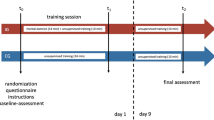Abstract
Background: The acquisition of laparoscopic skills is difficult to assess. Previously, through the use of a computer-based skills assessment device (SAD), we have shown that assessments of the time needed to perform a task and graded observations of task performance overestimate the speed at which laparoscopic skills can be acquired. The aim of this study was to test the ability of a laparoscopic SAD to differentiate novices from experienced laparoscopic surgeons and thereby further validate its use in surgical education. Methods: Using a laparoscopic simulator platform integrated with task simulation and data collection software (MIST VR), we tested both experienced and novice laparoscopists. Each group performed three tasks with a minimum of seven repetitions. The tasks consisted of target acquisition, target traversal, and target manipulation with diathermy. Within each task, time (T), errors (E), and economy of movement for each hand (EML, EMR) were assessed. Results were reported as mean ± SEM, and comparisons were made using an independent samples t-test. Results: For the target acquisition task, the expert group performed the task faster than the novice group (5.5 ± 0.24 vs 7.6 ± 0.40 sec, p <0.05); the experts also made fewer errors (0.5 ± 0.10 vs 0.8 ± 0.11 errors, p <0.05), and achieved both a better EML (1.8 ± 0.6 vs 2.3 ± 0.9, p <0.05) and a better EMR (2.0 ± 0.1 vs 2.9 ± 0.21, p <0.05). In the target traversal task, the experts made fewer errors than the novices (2.2 ± 0.25 vs 4.6 ± 0.38 errors, p <0.05). For the manipulation and diathermy tasks, the expert group completed the task faster (30.8 ± 1.5 vs 39 ± 1.5 sec, p <0.05), made fewer errors (5.3 ± 0.59 vs 8.1 ± 0.63 errors, p <0.05), and had a better EML (6.0 ± 0.37 vs 7.2 ± 0.45, p <0.05) and EMR (4.3 ± 0.23 vs 5.8 ± 0.36, p <0.05) than the novices. Conclusion: A laparoscopic skills assessment device can discern levels of laparoscopic manipulative skill. This type of device can be used in surgical training to make objective assessments of the acquisition of laparoscopic skills.
Similar content being viewed by others
Author information
Authors and Affiliations
Rights and permissions
About this article
Cite this article
McNatt, S., Smith, C. A computer-based laparoscopic skills assessment device differentiates experienced from novice laparoscopic surgeons. Surg Endosc 15, 1085–1089 (2001). https://doi.org/10.1007/s004640080022
Published:
Issue Date:
DOI: https://doi.org/10.1007/s004640080022




